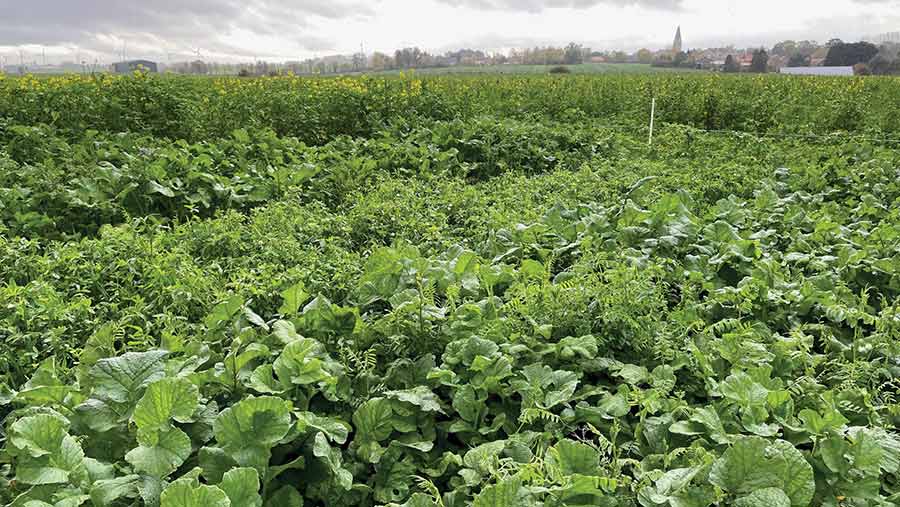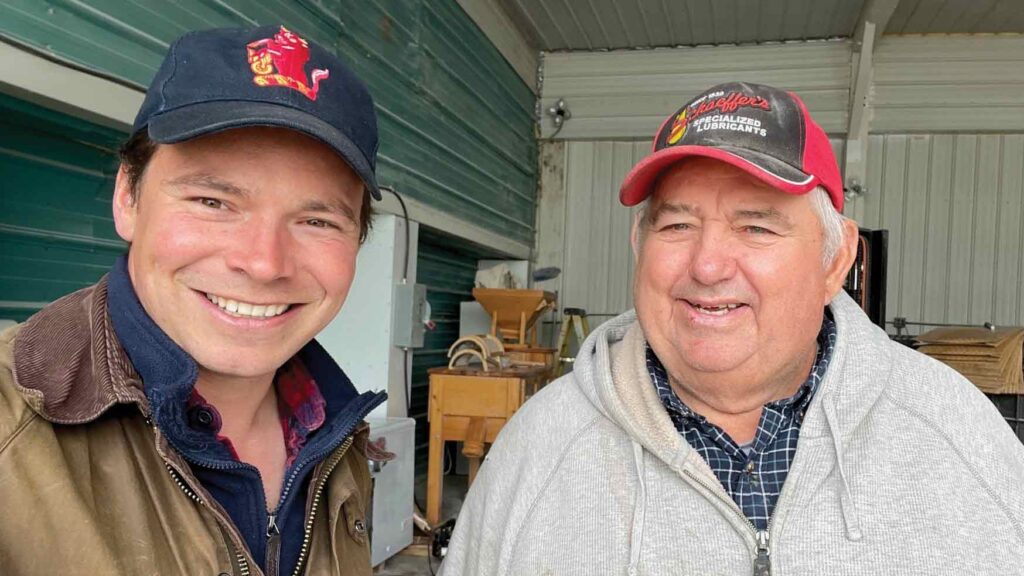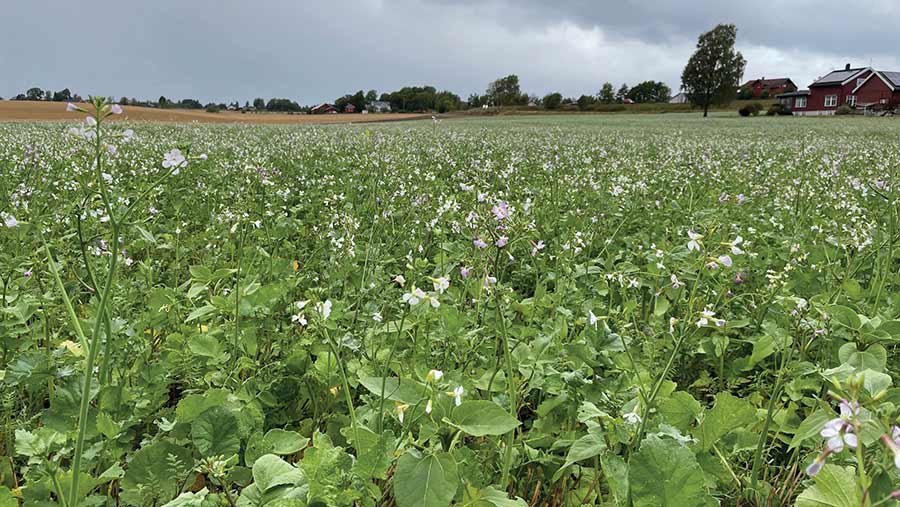Nuffield Scholar assesses the benefits of cover cropping
 Cover crops trial in France © Toby Simpson
Cover crops trial in France © Toby Simpson Cover crops are the keystone to the biological, chemical and physical function of the soil.
This is according to Northamptonshire arable farmer and 2022 Nuffield Scholar Toby Simpson, whose study addressed the practicalities and opportunities of cover cropping.
“A living root will physically structure, biologically feed, and chemically alter the soil around it. Biologically, plants convert carbon from the atmosphere into food. Roots feed fungi and bacteria in exchange for nutrients,” says Toby.
See also: Can you farm carbon? One Nuffield scholar seeks answers
“Decaying plant residues are a feast for soils and it is this microbial biomass – along with decomposed plant materials – that accounts for most soil organic matter.
“There are more living organisms in a spade of soil, than humans on earth. Soil and plants are fundamentally linked – neither can survive without the other and we depend on their survival for our existence.”
As part of his Nuffield Scholarship, Toby travelled to an array of farms across Europe and North America to better understand cover cropping practice in the UK.
North American research
In North America last year, Toby saw first-hand how the adoption of no-till and cover crops had fundamentally changed soils for the better.
A visit to Ohio farmer David Brandt, who had been no-tilling and cover cropping for more than 50 years, was a real eye-opener.
“David showed me the most beautifully crumbly structured soil, alive with worms. The soil had not been beaten by tillage and over-applied with fertilisers or sprays,” says Toby.
Instead, for 50 years, David had continued to feed his soils with plants and residues, allowing the soil’s own ecosystem to thrive and support his crops.
“For David, no answers came in a bottle – it was all down to the soil. In fact, there was nothing particularly complicated about what he did – as he put it, all he did was plant the seed.
“He told me that thanks to all his cover crop residues, every time it rained, he got compost tea.”
These practices allowed David to reduce inorganic fertiliser use by more than 75%, profiting not only his business but also environment.
David was essentially feeding his soils and, in turn, his soils were feeding his crops.
Soils were so transformed over the years, they had been reclassified – rising from 0.5% organic matter to over 8%.
Crops were rich in nutrients too – corn flour from the farm proved high in zinc and in trial work at Ohio State University, it was prescribed to zinc-deficient patients, with beneficial results.
Just three weeks after Toby’s visit last year, David passed away. Reading the tributes, Toby realised just how many lives David had influenced during his farming career.

Toby Simpson and David Brandt © Toby Simpson
European travels
Visits to Scandinavia highlighted the importance of timely cover crop establishment and termination.
“Scandinavian farmers are faced with a shorter growing season than the UK so their challenge is getting crops established.
“Farmers often broadcast a high seed rate ahead of harvest to maximise the summer growing conditions.”

Visits to Scandinavia showed the importance of timely cover crop establishment and termination © Toby Simpson
Toby believes cover crops should be treated like any other crop and recommends timely establishment into moisture, drilling at slow speeds, with good seed-to-soil contact.
When it comes to cover destruction, timing is everything as this determines the fresh organic material’s carbon to nitrogen (C:N) ratio and ability to cycle nutrients.
In mainland Europe, Toby met farmers who planted diverse cover mixes to promote soil carbon and nitrogen cycling.
“As a farmer in France said: ‘worms can’t climb trees.’ For a residue to be broken down and the process of cycling nutrients to begin, it needs to be accessible to soil microbes.”
Carbon-to-nitrogen ratio
By rolling or mulching cover crops midway through flowering, the soil C:N was optimally balanced for microbial decomposition.
This meant soil microbes could break down residues on the soil surface, helping kickstart cycling of nutrients, while protecting the soil.
To avoid poor crop establishment through nutrient lock-up, Toby discovered the importance of carbon and nitrogen flow through the soil.
“All residues have an amount of carbon and nitrogen that can be expressed as a ratio.
“Typically, soils have a C:N ratio of about 10kg C to 1kg N. Generally, a C:N ratio of 24:1 is optimal for soil microbial decomposition.
“At 24:1, soil microbes can both maintain and digest fresh organic matter. Generally, residues over 30:1 can cause nitrogen immobilisation.
“Below 20:1 can mineralise nitrogen and force microbes to seek out existing soil carbon,” explains Toby.
Chopped wheat straw residue of 80:1 requires microbes to use existing nitrogen to digest it, making it temporarily unavailable to plants.
When direct-drilling, soil organic matter is not mineralised, so nutrient immobilisation can occur, he continues.
The decomposition rate and carbon cycle of plant residues depend on the material, termination method, microbial populations and climatic factors.
Where nutrient lock-up is unlikely to impact the following crop, many farmers drill direct into covers, which works well when a cover has a low C:N.
“For early drilled spring cereals on heavy land in the UK, early termination of cover crops help mitigate lock-up.
“However, later drilling on lighter drought-prone soils suit drilling on the green,” he says.
Findings into practice
Toby believes setting achievable objectives and focusing on the functionality, diversity, and density of cover crops will benefit UK growers.
“Firstly, identify where a catch or cover crop can be grown in the rotation, then plan what you want to achieve.”
For example, if nutrient cycling for the following crop is the objective, the cover crop might be a mix of legumes and scavengers, aiming for fast-growing biomass, terminated while the C:N ratio is low, usually around flowering.
Timing of the termination should be planned so the residue has time to break down and release nutrients to the following crop.
If building soil organic matter and sequestering carbon is the main objective, a dense rooting, high C:N ratio residue with predominantly grasses would be preferable.
“However, it is not straightforward as the following crop might suffer nitrogen lock-up, so a legume or combining cereals with a starter fertiliser might be appropriate in this situation,” he notes.
“I’ve seen a multitude of great reasons for growing cover crops many of which are interlinked.
“It could be erosion prevention, water management, soil improvement, weed and pest control, livestock foraging, habitat creation, nutrient cycling or financial benefits.”
That’s why Toby has made it his mission at his family arable farm in Northamptonshire to continually cover as much of the soil as possible.
For his business to be sustainable and profitable, he says he can’t afford not to.
However, he notes this should be viewed in the context of a farmer’s own soil, climate and business, as what works for one might not be a solution for all.
“Our soils are alive, so let’s feed them,” he concludes.
Key messages from Toby Simpson’s Nuffield Farming Scholarship
When growing cover crops, think functionality, diversity, density and set out clear objectives:
- Function This will inform the cover crop species selection, establishment, management, termination and following crop performance
- Diversity This will provide a plethora of above and below-ground cover crop residues that will feed a multitude of microbes and help cycle soil nutrients
- Density Soil function will be influenced in several ways, from weed suppression and water management to nutrient cycling
- Understanding the C:N ratio of cover crops is beneficial for successful outcomes
- Treat the cover crop with the same care and attention as a cash crop
- Consider individual context as this varies between farms and fields.

